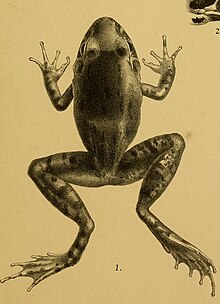
Marquis Giacomo Doria was an Italian naturalist, botanist, herpetologist, and politician.
Doria's green snake is a species of snake in the family Colubridae. The species is endemic to Asia.

Limnonectes is a genus of fork-tongued frogs of about 75 known species, but new ones are still being described occasionally. They are collectively known as fanged frogs because they tend to have unusually large teeth, which are small or absent in other frogs.

Brachytarsophrys feae is a species of amphibian in the family Megophryidae. It is found in southern China and northern Myanmar, Thailand, and Vietnam; it is likely to occur in Laos. The specific name feae honors Leonardo Fea, an Italian explorer, zoologist, and naturalist.

Xenophrys aceras, commonly known as the Perak horned toad, Perak spadefoot toad or Malayan horned frog, is a species of frog in the family Megophryidae found in Peninsular Malaysia and Thailand, and possibly in Indonesia. Its common name refers to its type locality, Bukit Besar in Perak state, Malaysia.

Xenophrys longipes is a species of frog in the family Megophryidae. It is also known as the Malacca spadefoot toad, red legged spine-eyed frog, red-legged horn frog, and slender-legged horned frog. It is found in the Malay Peninsula. Records from Cambodia and Vietnam are considered doubtful.
Callulops doriae is a species of frog in the family Microhylidae. It is endemic to Papua New Guinea and occurs in the eastern mainland Papua New Guinea and in Tagula Island, Louisiade Archipelago. It is the type species of the genus Callulops erected by George Albert Boulenger in 1888. Common name Doria's callulops frog has been coined for this species.
Limnonectes liui is a species of frog in the family Dicroglossidae. It is found in Yunnan, China, but it likely occurs also in nearby Laos and Myanmar. The taxonomic placement of this species has been much debated and varies between sources.

Blyth's river frog, Blyth's frog, giant Asian river frog, or (ambiguously) giant frog, Limnonectes blythii, is a species of frog in the family Dicroglossidae found from Myanmar through western Thailand and the Malay Peninsula to Sumatra and Borneo (Indonesia). Earlier records from Laos and Vietnam are considered misidentifications.
The Malesian frog, Malaysian river frog, Malaysian peat frog, or peat swamp frog is a species of frog in the family Dicroglossidae. It is found on the Malay Peninsula, Sumatra, Java, Borneo, and a range of islands on the Sunda Shelf . Its natural habitats are shallow, gentle streams and nearby swampy areas including peat swamps, very flat alluvial forests, and overgrown plantations. It is becoming rare due to habitat loss (deforestation), and to a lesser extent, exploitation.

Limnonectes microtympanum is a species of frog in the family Dicroglossidae. It is endemic to Sulawesi, Indonesia, where it is only known from the Moncong Lompobatang mountain at elevations above 1,000 m (3,300 ft).

Limnonectes palavanensis is a species of frog in the family Dicroglossidae. It is found in the Palawan Island and in Borneo. The species shows paternal care, a relatively rare trait in frogs.

Limnonectes paramacrodon is a species of frog in the family Dicroglossidae. It is found in Malay Peninsula, Borneo, and Natuna Besar. Its natural habitats are lowland swamp forest areas with small rivers and streams. It is becoming rare due to habitat loss.
Limnonectes tweediei is a species of frogs in the family Dicroglossidae. It is found in Sumatra (Indonesia) and the Malay Peninsula (Malaysia).

Nanorana feae is a species of frog in the family Dicroglossidae. It is found in Yunnan, China, and the Kachin Hills in Myanmar. The specific name feae honors Leonardo Fea, an Italian explorer, zoologist, and naturalist. This little-known species probably inhabits hill streams in forested areas.

Chirixalus doriae, commonly known as Doria's Asian treefrog, Doria's bush frog, Doria's bush frog, and Doria's tree frog, is a species of frog in the family Rhacophoridae. It is found in southeastern Asia, from extreme northeastern India and adjacent Bangladesh to Myanmar, Thailand, Cambodia, Laos, Vietnam, and southern China.

Raorchestes parvulus is a species of frog in the family Rhacophoridae. It is found from eastern Bangladesh east through Myanmar and Thailand to Cambodia, northern Vietnam, Laos, and Peninsular Malaysia. Its distribution might well extend into northeastern India and southern China. This species was first described by George Albert Boulenger based on seven specimens collected by Leonardo Fea from Karen Hills, Burma.
Tropidonophis doriae, commonly known as the barred keelback, is a species of snake belonging to the family Colubridae. The species is native to New Guinea and some nearby islands.
Scincella doriae, also known commonly as Doria's ground skink and Doria's smooth skink, is a species of lizard in the family Scincidae. The species is native to Southeast Asia.
Agama doriae, also known commonly as the Benoue agama, Doria's agama, and the Nigeria agama, is a species of lizard in the family Agamidae. The species is endemic to Africa. There are two recognized subspecies.













